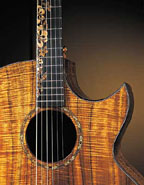

Kī hō‘alu - (slack key) is a fingerstyle genre of guitar music that originated in Hawai‘i. Its name refers to its characteristic tuning: the English term is a translation of the Hawaiian kī hō‘alu, which means "loosen the [tuning] key". Most slack-key tunings can be achieved by starting with a classically-tuned guitar and detuning or "slacking" one or more of the strings until the six strings form a single chord.
Kī hō‘alu is often characterized by the use of an alternating-bass pattern, usually played by the thumb on the lower two or three strings of the guitar, while the melody is played on the three or four highest strings, using any number of fingers. Many kī hō‘alu players incorporate various embellishments such as harmonics (chimes), the hammer-on, the pull-off, slides, and damping. Slack key compositions exhibit characteristics from indigenous Hawaiian and imported musical traditions. The vamp or turnaround (a repeated figure, usually at the end of a verse) is descended from the hula tradition, and other harmonic and structural features are descended from hīmeni and from the hula ku'i encouraged by King David Kalakaua.
Nearly all slack key requires retuning the guitar strings from the standard EADGBE, and this usually (but not always) means lowering or "slacking" several strings. The result will most often be a major chord, although it can also be a major-seventh chord, a sixth, or (rarely) a minor. (There are examples of slack key played in standard tuning, but the overwhelming majority of recorded examples use altered tunings.) The most common slack key tuning, called "taro patch," makes a G major chord. Starting from the standard EADGBE, the high and low E strings are lowered or "slacked" to D and the fifth string from A down to G, so the notes become DGDGBD. As the chart below shows, there are also major-chord tunings based on C, F, and D.
Another important group of tunings, based on major-seventh chords, is called wahine (Hawaiian for "woman"). G wahine, for example, starts with taro patch and lowers the third string from G to F#, making DGDF#BD. Wahine tunings have their own characteristic vamps (as in, for example, Raymond Kāne's "Punahele" or Gabby Pahinui's 1946 "Hula Medley") and require fretting one or two strings to form a major chord. A third significant group is Mauna Loa tunings, in which the highest pair of strings are a fifth apart: Gabby Pahinui often played in C Mauna Loa, CGEGAE.
There are many slack key tunings--George Winston has identified fifty--with some tunings only commonly used for a single song, or by particular players. The most common tuning is Taro Patch, which is a G-major tuning. Mike McClellan and George Winston have developed schemes that organize the tunings by key and type. The chart below follows their categories and naming conventions.
| Common Slack Key Tunings | Notes Used |
|---|---|
| G Major or Taro Patch | D G D G B D |
| G Wahine | D G D F# B D |
| D Wahine | D A D F# A C# |
| Open D | D A D F# A D |
| C Major or Atta's C | C G E G C E |
| Mauna Loa | C G E G A E |
| C Wahine or Leonard's C | C G D G B D |
| C 6 | C G C G A E |
| Old Mauna Loa | C G C G A D |
| Open C | C G C E G C |
| F Wahine | C F C G C E |
| Open F | C F C F A C |
| Double Slack F | C F C E A C |
![]() Back to Home
Page
Back to Home
Page